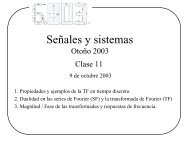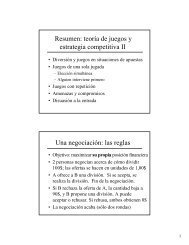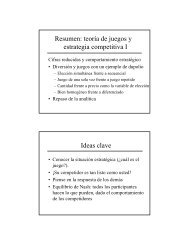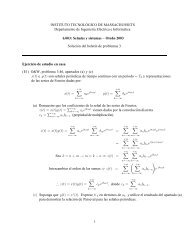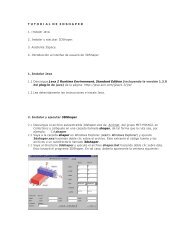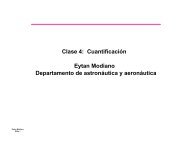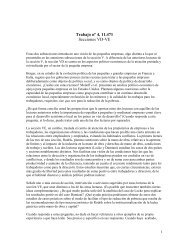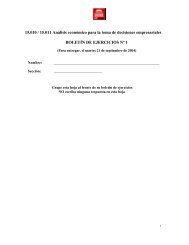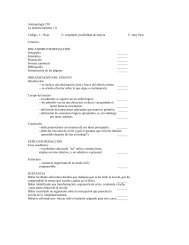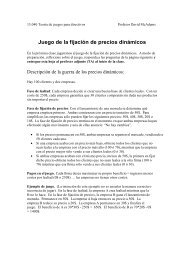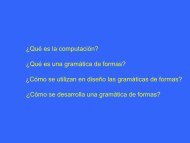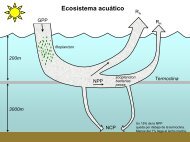Market Definition
Market Definition
Market Definition
Create successful ePaper yourself
Turn your PDF publications into a flip-book with our unique Google optimized e-Paper software.
15.010/15.011: ECONOMIC ANALYSIS FOR BUSINESS DECISIONS<br />
MIDTERM EXAM REVIEW SESSION<br />
OCTOBER 9, 2004<br />
PAGE<br />
MARKET DEFINITION, SUPPLY/DEMAND, ELASTICITIES 2<br />
GOVERNMENT POLICIES 7<br />
PRODUCTION/COST 13<br />
NETWORK EXTERNALITIES 17<br />
LEARNING CURVE 20<br />
DYNAMIC DEMAND 25<br />
TIME AND UNCERTAINTY 31<br />
MONOPOLIES, MARKET POWER 36<br />
MIDTERM SECRET KEY 42<br />
Midterm Review 1 10/06/04
<strong>Market</strong> <strong>Definition</strong><br />
A market is a collection of buyers and sellers, resulting in the possibility for exchange.<br />
<strong>Market</strong> boundaries are defined in both geographic terms and in terms of a range of<br />
products.<br />
• Demand Substitutability:<br />
− Would consumers adjust purchases of good A when the price of good B changes?<br />
• Supply Substitutability:<br />
− Would producers modify production of good A as a result of a change in the price of<br />
good B?<br />
Midterm Review 2 10/06/04
<strong>Market</strong> <strong>Definition</strong><br />
Example:<br />
True / False: Fast food chains like McDonald’s, Burger King, and Wendy’s operate all over<br />
the United States. Therefore, from the consumer’s perspective, the market for fast food is a<br />
national market.<br />
Answer:<br />
False. San Francisco consumers won’t travel to New York to buy a BigMac there even if the<br />
price is lower (or has decreased) in New York.<br />
Midterm Review 3 10/06/04
Supply and Demand<br />
Where do the curves come from and what do they represent?<br />
• Demand<br />
• Supply<br />
− Aggregate reservation prices of the market. What consumers are willing to pay.<br />
− How much consumers will buy at a particular price<br />
− Linear Demand: Qd = a - b P<br />
− Isoelastic Demand: ln(Qd) = a - b ln(P)<br />
− Aggregate marginal cost curves of an industry<br />
− How much will producers provide at a particular price<br />
− Linear Supply: Qs = c + d P<br />
− Isoelastic Supply: ln(Qs) = c + d ln(P)<br />
Midterm Review 4 10/06/04
Elasticities<br />
An elasticity is a measure of the sensitivity of one variable to another. For our purposes, it is<br />
the percentage change in quantity (demanded / supplied) in response to a 1 percent increase in<br />
price, income, etc.<br />
• Price elasticity of demand<br />
− Linear Demand: Ed = - b P<br />
Q<br />
− Isoelastic Demand: Ed = - b<br />
• Price elasticity of supply<br />
– Linear Supply: Ed = d P<br />
Q<br />
– Isoelastic Supply: Ed = d<br />
• Cross-price elasticity of demand<br />
− Substitutes: positive cross price elasticity (butter and margarine)<br />
− Complements: negative cross price elasticity (cars and gasoline)<br />
Midterm Review 5 10/06/04
• Short run and long run elasticities may be different.<br />
Example:<br />
– Consumable Goods: ESR < ELR (example: orange juice)<br />
– Durable Goods: ESR > ELR (example: cars)<br />
True / False: The potential gain to the OPEC cartel from agreeing to production cutbacks and<br />
adhering to the agreement is greater if the elasticity of supply is low rather than if it is high.<br />
Answer:<br />
True. If supply is inelastic (e.g., low), a small production cutback will result in a large price<br />
increase.<br />
Example:<br />
What happens to elasticity along a linear demand curve as Q increases?<br />
Ed = -b*P/Q<br />
Thus, as Q increases, demand becomes less elastic.<br />
Midterm Review 6 10/06/04
P0<br />
Government Policies:<br />
Unregulated, Competitive <strong>Market</strong><br />
CS<br />
PS<br />
Q0<br />
Measuring Impact of Government Policies:<br />
• Consumers and producers buy and sell at<br />
market clearing price<br />
• Consumer surplus: for some consumers, the<br />
value of the good exceeds the market price<br />
• Producer surplus: some producers produce units<br />
at a cost lower than the market price<br />
• Start with unregulated competitive market<br />
• Determine new price, quantity given government policy<br />
• DWL is resultant loss of welfare after all transfer of surplus between producers, consumers,<br />
government and foreign entities.<br />
Midterm Review 7 10/06/04
P0<br />
Government Policies: Price Control<br />
Unregulated <strong>Market</strong>: Price Control: Maximum Price P1<br />
CS<br />
PS<br />
Q0<br />
S<br />
D<br />
P0<br />
P1<br />
A<br />
Q1<br />
B<br />
C<br />
Q0<br />
S<br />
D<br />
A – Transfer from<br />
producers to<br />
consumers.<br />
Consumers who can<br />
purchase good do so at<br />
a lower P<br />
B – some consumers can<br />
no longer buy the<br />
good.<br />
C – some producers can no<br />
longer sell the good<br />
∆CS = A – B<br />
∆PS = -(A + C)<br />
DWL = -(B + C)<br />
Midterm Review 8 10/06/04
Example: If supply is very inelastic, do consumers gain or lose on net from imposition of<br />
Pmax? Why? – If Pmax > PFree, then the price ceiling is irrelevant. Consumers will gain when<br />
Pmax < PFree when ∆CS is positive. Obviously, ∆CS will be positive when A > B as shown<br />
above. Given the demand curve depicted above, for very inelastic supply curves, A > B,<br />
therefore consumers will be better off.<br />
Midterm Review 9 10/06/04
Government Policies: Taxes<br />
Unregulated <strong>Market</strong>: Taxes: t<br />
P0<br />
CS<br />
PS<br />
Q0<br />
S<br />
D<br />
Pd<br />
A<br />
t B<br />
P0<br />
D<br />
C<br />
Ps<br />
Q1<br />
Q0<br />
S<br />
D<br />
Pd = Ps + t<br />
QD = QD(Pd)<br />
QS = QS(Ps)<br />
QD = QS = Q1<br />
∆CS = -(A + B)<br />
∆PS = -(C + D)<br />
Govt = A + D<br />
DWL = -(B + C)<br />
To solve taxes exercises, follow these steps:<br />
1) Express QD = QD(Pd) and QS = QS(Ps) [Demand and Supply in terms of Pd and Pd]<br />
2) Use [Pd = Ps + t] to replace Pd in the demand curve (or alternatively replace Ps in supply<br />
curve)<br />
3) Equate QD = QS and solve for price Pd (or alternative Ps). Find Q1 using one of the<br />
equations and the price.<br />
4) If you are asked for CS, PS and DWL, use the graph to calculate areas (remember to find<br />
the intercepts of the curves on the y-axis by making Q=0 in each curve).<br />
Midterm Review 10 10/06/04
Impact of a tax depends on εs and εd.<br />
ε s<br />
Fraction of tax borne by consumers = = PASS THROUGH FORMULA<br />
ε s − ε d<br />
Note: the higher the elasticity of demand (supply), the less the burden for consumers<br />
(producers)<br />
P<br />
P<br />
Elastic Demand<br />
S<br />
Q<br />
D<br />
Elastic Supply Inelastic Supply<br />
P<br />
S<br />
Midterm Review 11<br />
Q<br />
D<br />
S<br />
P<br />
Inelastic Demand<br />
D<br />
S<br />
Q<br />
Q<br />
D<br />
10/06/04
Government Policies: Tariffs/Quotas<br />
Without a tariff or quota, a company will import a good when Pworld < Pmarket if there were no<br />
imports<br />
Unregulated <strong>Market</strong>: Tariff OR Quota<br />
Pworld<br />
PS<br />
CS<br />
Imports<br />
Sdomestic<br />
Sunregulated<br />
P1<br />
Pworld<br />
A<br />
B D C<br />
Quota<br />
Qdomestic Qdomestic<br />
Q0 Q1 Q0<br />
S *<br />
Tariff<br />
∆CS = -(A + B + C + D)<br />
∆PS = A<br />
Quota: Gain to Foreign Producers = D<br />
Tariff: Gain to Government = D<br />
DWL = -(B + C)<br />
Midterm Review 12 10/06/04
Production Costs: Terms<br />
• Economies of Scale<br />
Means you can double output without a doubling of costs<br />
Marginal costs are less than average costs<br />
• Diseconomies of Scale<br />
Means that if you double output, you more than double costs<br />
Marginal costs are greater than average costs<br />
• Constant Costs<br />
If you double output, your costs exactly double<br />
Point where marginal costs equal average costs<br />
Midterm Review 13 10/06/04
Total Cost Fixed cost<br />
TC = 5000 + 20Q + 0.5Q 2<br />
Average Total Cost<br />
ATC = TC/Q<br />
600<br />
500<br />
400<br />
300<br />
200<br />
100<br />
0<br />
10<br />
40<br />
Variable cost (anything with<br />
‘Q’ in it)<br />
= 5000/Q + 20 + 0.5Q<br />
Fixed costs distributed over<br />
larger production volume<br />
70<br />
100<br />
130<br />
160<br />
190<br />
220<br />
250<br />
280<br />
310<br />
340<br />
370<br />
400<br />
Rising marginal cost (cost of<br />
producing one more unit rises as<br />
more units are produced)<br />
Midterm Review 14 10/06/04
How do we find the minimum ATC?<br />
Note, before we reach minimum ATC, each additional unit costs LESS than the ATC (and<br />
results in a lower ATC); after we’ve passed minimum ATC, each additional unit costs MORE<br />
than the ATC (resulting in a higher ATC). At the minimum ATC, an additional unit produced<br />
costs the SAME as the ATC.<br />
Marginal Cost<br />
MC = ∂TC/∂Q<br />
= ∂[5000 + 20Q + 0.5Q 2 ]/ ∂Q<br />
= 20 + Q<br />
Minimum ATC at intersection of ATC and MC: 20 + Q = 5,000/Q + 20 + 0.5Q<br />
Q = 5,000/Q + 0.5Q<br />
0.5Q = 5,000/Q<br />
0.5Q 2 = 5,000<br />
Q 2 = 5,000/0.5<br />
= 10,000<br />
Q = 100 units<br />
Midterm Review 15 10/06/04
Economic vs. Accounting Cost<br />
Opportunity costs Economists include opportunity costs as part of cost - accountants do<br />
not. Opportunity costs are the cost of opportunities forgone by not putting a resource to the<br />
highest value alternative use.<br />
Depreciation Economists and accountants measure depreciation differently. Economists<br />
focus on actual wear-and-tear of equipment when determining the decline in economic value<br />
of machines - accountants will classify assets according to tax rules to allocate the cost of an<br />
investment over time.<br />
How do you measure wear-and-tear on a machine? determine the current market value of the<br />
asset and then deduct the value of the same asset manufactured one year earlier. What if you<br />
bought a highly specialized machine, and its value in the marketplace is now zero (e.g.<br />
machine which is obsolete)? It is a sunk cost.<br />
Sunk costs these are costs already spent and unrecoverable - Economists exclude these<br />
from consideration once expended; accountants may include them under certain conditions<br />
(e.g. if an obsolete machine which cannot be resold is not fully depreciated for accounting<br />
purposes, it is still a “cost” for the accountant).<br />
User cost of capital Cost of holding onto capital. UCC = (r + depr %) Vt<br />
Midterm Review 16 10/06/04
Network Externalities<br />
• Quantity Demanded depends on belief / knowledge about demand of others<br />
• Direct network externalities (e.g., email, IM, telephone)<br />
• Indirect network externalities (e.g., platforms like Windows, XBox)<br />
• Snob effect (e.g., works of art, sports cars)<br />
Midterm Review 17 10/06/04
Network Externalities<br />
see Figure 4.15: Positive Network Externality: Bandwagon Effect<br />
Robert Pindyck and Daniel Rubinfeld, Microeconomics, 5th edition, (Upper Saddle River, NJ: Prentice-Hall, 2000)<br />
Midterm Review 18 10/06/04
TRUE/FALSE<br />
The snob effect makes market demand more elastic.<br />
FALSE: If Rolex lowers its prices, many consumers will purchase Rolex watches because of<br />
the price effect (i.e., from the definition of the demand curve, when P goes down, Q<br />
demanded goes up). Because there is a snob effect, however, the value of a Rolex will<br />
decline, and the extent to which Q demanded increases will be reduced. Thus, the snob effect<br />
makes market demand less elastic.<br />
Midterm Review 19 10/06/04
Learning Curves<br />
When do they occur? When costs decrease with cumulative production (workers and<br />
managers learn how to “optimize” as they keep producing).<br />
Examples: aircraft assembly, chip production, etc.<br />
$1,400<br />
$1,200<br />
$1,000<br />
$800<br />
$600<br />
$400<br />
$200<br />
$-<br />
AC<br />
NO LEARNING LEARNING<br />
Period Qt ACt 1 10 $ 975<br />
2 30 $ 375<br />
3 30 $ 375<br />
4 30 $ 375<br />
NO LEARNING<br />
0 10 20 30 40 50 60<br />
The AC curve stays there! Any changes in AC are due<br />
to Economies or Diseconomies of Scale only.<br />
Q<br />
$1,400<br />
$1,200<br />
$1,000<br />
$800<br />
$600<br />
$400<br />
$200<br />
$-<br />
Period Qt CPt-1 ACt 1 10 0 $ 975<br />
2 30 10 $ 262<br />
3 30 40 $ 215<br />
4 30 70 $ 198<br />
LEARNING<br />
AC CP=0<br />
CP=10<br />
CP=40<br />
CP=70<br />
0 10 20 30 40 50 60<br />
The AC curve SHIFTS DOWN because there is<br />
learning: As CP go up, the AC shifts down<br />
Important: The AC curve does not shift down<br />
indefinitely. There are limits for learning!<br />
Midterm Review 20 10/06/04<br />
Q
What is NOT a learning curve?<br />
• When the reduction in costs is due to reduction in input prices (not to increased CP)<br />
How does it look like in the equations?<br />
Basically, wherever you see “CP” on it, and the more CP the less costs (holding everything<br />
else equal), chances are there is learning going on. Examples:<br />
• lnACt = 1.75 - 0.20 lnQt - 0.25 lnCPt-1<br />
• TC = 5,000 + (100×0.8 CP )×Q + 0.05×Q 2<br />
• Etc.<br />
Midterm Review 21 10/06/04
Pricing with Learning<br />
Objective: Maximize TOTAL profits (Πtotal=πtoday+πtomorrow+π3+π4+…)<br />
• Myopic output/pricing decision (wrong): Set MR in every period = MC in every period.<br />
This way we ignore the learning benefit of producing extra units.<br />
• Correct approach:<br />
Set MC = MR + correction for reduced future costs from producing one more unit today<br />
This way we recognize the future learning benefits of producing more today.<br />
Pricing with Network Externalities<br />
The concept is similar to pricing with learning curves.<br />
In the presence of Network Externalities:<br />
Set MC = MR + correction for additional MR realized in the future due to bandwagon<br />
effect of one more unit now<br />
Midterm Review 22 10/06/04
Wait a minute! If I start selling at this low P*, I won’t be maximizing my current<br />
profits because MR
TRUE / FALSE / UNCERTAIN<br />
Your firm produces a new, patented Super Gelato home ice cream maker. You are about to<br />
begin production, and you must decide what price to use. Your marginal cost in the short run<br />
is constant, however, you expect it to drop in a few years, when the cost of the coolant used in<br />
the ice cream maker will no longer be patented and will drop in price. You expect this to<br />
drop your MC from about $100 to about $50. Thus, in setting your current production as well<br />
as your long-run production, you should use a MC figure of $50.<br />
FALSE. This is not a learning curve case! The reduction in MC is due to the patent<br />
expiration, no matter if I produce or not. Therefore, in each period, Super Gelato production<br />
should be based on the marginal cost of producing in that period.<br />
Midterm Review 24 10/06/04
Dynamic Demand Response – Non - Durables<br />
• Examples are gasoline, heating oil, coffee. Goods that are consumed in one period.<br />
• Model Qt, Quantity of the good purchased in Period t.<br />
• Think of these goods as Habit Forming. The Quantity you buy today (period t) depends on<br />
the quantity that you bought yesterday (period t-1).<br />
• Over time, habits can change to reflect a price shock or an income shock<br />
• Long term Elasticities > Short term Elasticities (Absolute Value)<br />
• If price of good goes down, or if income of consumers goes up, result is a positive<br />
shock.<br />
Quantity<br />
Sold<br />
Original<br />
Equilibrium<br />
Sales<br />
Positive Shock<br />
New Equilibrium Sales<br />
(long term effect after<br />
positive shock)<br />
Time<br />
Midterm Review 25 10/06/04
Dynamic Demand Response – Non - Durables (cont.)<br />
• If price goes up or incomes go down, think of a negative shock<br />
Quantity<br />
Sold<br />
Original<br />
Equilibrium<br />
Sales<br />
Negative Shock<br />
New Equilibrium Sales<br />
(long term effect after<br />
negative shock)<br />
Time<br />
Midterm Review 26 10/06/04
Dynamic Demand Response – Non - Durables (cont.)<br />
• We can also observe the effect of a price increase on quantity sold using supply and<br />
demand charts.<br />
P<br />
S<br />
Initial Equilibrium<br />
S.T. Equilibrium<br />
P’ Q decreases a little initially<br />
P<br />
QLT<br />
QST<br />
Q<br />
0<br />
DShort-term<br />
L.T. Equilibrium<br />
DLong-term Q decreases more later<br />
Qsold<br />
Midterm Review 27 10/06/04
Dynamic Demand Response – Durable Goods<br />
• Examples are Automobiles, Washing Machines, Televisions. Items that are useful for a<br />
number of periods.<br />
• Quantity that you buy today depends on last period stock level, this period’s desired stock<br />
level, and number of units that go out of service and need replacing.<br />
• Right after a shock, the gap between actual stock and desired stock is the largest.<br />
• Short Term Elasticities > Long Term Elasticities (Absolute Value)<br />
Midterm Review 28 10/06/04
Time and Uncertainty – Present Value<br />
• Cash received at different points in time has differing values for a firm or individual<br />
• Present Value allows us to take a future stream of cash flow, profits, revenue, costs, etc.<br />
and convert them to a single comparable value for the present<br />
• Use interest rate or discount rate (R) to ‘convert’ future values to present values<br />
• NPV can be used for capital budgeting decisions—only choose projects with NPV > 0<br />
PV = C0 + C1/(1+R) + C2/(1+R)2 + ….+ CT/(1+R)T<br />
where Ct is the (positive or negative) cash flow at time t<br />
Midterm Review 31 10/06/04
Time and Uncertainty – Uncertainty and Risk Aversion<br />
• Events and cash flows in the future are often uncertain, but can be modeled as a random<br />
variable<br />
• Expected value represents ‘average’ cash flow<br />
E(X) = p 1 X1+p2X2+p3X3+ ….+ pNXN<br />
• Firms can use expected value of cash flows to make capital budgeting decisions<br />
•<br />
Attitudes toward risk often dictate behavior:<br />
• Risk averse: These people prefer a certain outcome over an uncertain, or risky, outcome with<br />
the same expected value.<br />
• Risk neutral: These people have no preference for a certain outcome over an uncertain, or risky,<br />
outcome with the same expected value.<br />
• Risk loving: These people prefer an uncertain, or risky, outcome over a certain outcome with<br />
the same expected value.<br />
Midterm Review 32 10/06/04
Time and Uncertainty – Option Value<br />
•<br />
Uncertainty of future events often means there is value to waiting until the uncertainty is<br />
reduced or eliminated<br />
• The value of an option can be calculated based<br />
Example:<br />
on the outcome of the uncertain events<br />
A firm can develop a new line of either laptops or PDAs. Each will take have a<br />
development cost of $1,000,000. If the economy recovers, they can sell 1000 laptop<br />
units<br />
at $1500 each, or they can sell 5500 PDAs at $250 each. If the economy does not recover,<br />
they can sell 800 laptop units at $1000 each, or 5000 PDAs at $225 each. There is a 50-50<br />
chance that the economy recovers. How much should the firm be willing to pay to keep<br />
both development options alive until they find out if the economy recovers?<br />
Answer:<br />
If<br />
the economy is good:<br />
Π (laptop) = 1000*$1500 - $1,000,000 = $500,000<br />
Π (PDA) = 5500*$250 - $1,000,000 = $375,000<br />
produce laptops<br />
Midterm Review 33 10/06/04
If the economy is bad:<br />
Π (laptop) = 800*$1000 - $1,000,000 = -$200,000<br />
Π (PDA) = 5000*$225 - $1,000,000 = $125,000<br />
produce PDA’s<br />
If we don’t know the state of the economy:<br />
Π (laptop) = 0.5*1000*$1500 + 0.5*800*$1000 – $1,000,000 = $150,000<br />
Π (PDA) = 0.5*5500*$250 + 0.5*5000*$225 – $1,000,000 = $250,000<br />
produce PDAs<br />
If we select a product after determining the state of the economy, we can get expected<br />
profits of:<br />
0.5*$500,000 + 0.5*$125,000 = $312,500<br />
If we select a product before learning the state of the economy, we can get expected<br />
profits<br />
of:<br />
$250,000<br />
Option value of keeping both options alive until we learn the state of the economy:<br />
$312,500 - $250,000 = $62,500<br />
Midterm Review 34 10/06/04
Question (True or False?)<br />
When choosing between two capital projects, a firm will always choose the project with<br />
higher future cash flows in each year.<br />
Answer<br />
False.<br />
Why?<br />
Because of relative riskiness of each project.<br />
A riskier project will have a higher R as compared to a safer project. So although a project<br />
has higher future cash flows, it may have a lower NPV than a project with smaller future cash<br />
flows.<br />
Midterm Review 35 10/06/04
Monopoly: <strong>Market</strong> with only one seller (P&R fig. 10.3)<br />
• The objective is to maximize profits: Π=TR-TC<br />
• This requires<br />
MR = MC<br />
•<br />
Demand is the average revenue curve. If demand is linear, MR is linear. Therefore, it has<br />
the intercept<br />
and twice the slope as the inverse demand curve, P(Q).<br />
• Marginal revenue can be calculated from demand equation as:<br />
•<br />
•<br />
MR =<br />
d<br />
( P⋅Q)<br />
dQ<br />
Output is determined by solving MR = MC for quantity. Price is obtained by plugging the<br />
optimal output in the demand equation.<br />
Reminder: A monopolistic market does not have a supply curve, in the sense that there is<br />
no one-to-one relationship between price and quantity produced. The reason is that the<br />
monopolist’s output decision depends not only on MC but also on the shape of the demand<br />
curve.<br />
Midterm Review 36 10/06/04
Monopoly power<br />
• A firm has monopoly power if it faces a downward sloping demand curve. Remember that<br />
in competitive markets firms face flat (completely<br />
elastic) demand curves at the market<br />
price.<br />
• A firm can have monopoly power even if it is not a monopolist. This happens, for instance,<br />
in the case of differentiated consumer goods like clothing.<br />
• The determinants of monopoly power are the elasticity of market<br />
demand, the number of<br />
firms in the market, the interaction among firms.<br />
• <strong>Market</strong> power can be measured by the ability of the firm to charge a markup above<br />
marginal cost. The degree of markup is related to the elasticity of demand:<br />
P − MC 1<br />
= −<br />
P E<br />
• Markup is higher when demand is less elastic. The intuition is that inflexible customers are<br />
willing to pay higher prices.<br />
Midterm Review 37 10/06/04<br />
D
Question:<br />
A firm with monopoly power has a constant marginal cost of $10 per unit, and is charging a<br />
price of $20 per unit.<br />
(1 ) If the firm is maximizing profit, what is the elasticity of demand?<br />
(2) Suppose its elasticity of demand doubles. What price should it then charge?<br />
Answer:<br />
(1) Using the markup formula we have:<br />
P − MC 1 20 − 10<br />
=− ⇒ =−<br />
P E 20<br />
1<br />
E ⇒ ED =−2<br />
D D<br />
(2)<br />
We use the markup formula again to find the price:<br />
P − MC<br />
P<br />
=− 1<br />
E D<br />
⇒<br />
P − 10<br />
P<br />
=− 1<br />
−4<br />
⇒ 4(P − 10) = P ⇒ P = 40<br />
3<br />
= 13.33<br />
Midterm Review 38 10/06/04
Monopolistic vs. competitive markets<br />
• In a monopolistic market output is lower, price is higher and profit is higher than in a<br />
competitive market (where equilibrium is determined by the intersection of demand and<br />
supply).<br />
• Monopoly creates deadweight loss, since the firm restricts output to maximize<br />
profits.<br />
• Monopolies<br />
have social costs. Therefore, they are usually regulated (e.g. with price<br />
ceilings) or prohibited (anti-trust laws).<br />
• Natural monopolies exist when firms have economies of scale over the entire output range<br />
because multiple competitors could not survive in a competitive market. In this case, the<br />
government frequently allows the monopoly and regulates it.<br />
Midterm Review 39 10/06/04
Multi-plant production<br />
Optimal condition is MR = MC1 = MC2= MCtotal. Otherwise, profits could be improved<br />
by<br />
changing production levels.<br />
1. Find MCtotal by horizontally adding the individual plants’ marginal cost curves.<br />
Horizontal sum is obtained by first solving marginal cost equations for quantities<br />
[obtaining Q1 = f(MCtotal), Q2 = g(MCtotal)] and then adding these expressions (Q =<br />
Q1 + Q2).<br />
2. Determine optimal output for the firm by setting MR = MCtotal.<br />
3. Calculate price by plugging total output into demand equation.<br />
4. Determine individual output levels using marginal cost equations, using optimal MCtotal<br />
calculated above.<br />
Midterm Review 40 10/06/04
Question (True or False?)<br />
A monopolist has two plants, one in Italy and another one in France. Due to a new tax on<br />
labor, the marginal cost at the Italian plant goes up. Production at both plants should be<br />
reduced<br />
to reflect increased total<br />
marginal cost.<br />
Answer<br />
False.<br />
Why?<br />
Before the tax, the monopolist is producing at the point where marginal cost is the same at<br />
both plants. When the tax causes the marginal cost to rise at the Italian plant, the firm will<br />
shift production away from the Italian plant and to the French plant until the marginal costs<br />
are equalized.<br />
Midterm Review 41 10/06/04
Midterm secret key (make sure you absolutely memorize it):<br />
Relax!!<br />
GOOD LUCK!!<br />
Midterm Review 42 10/06/04



